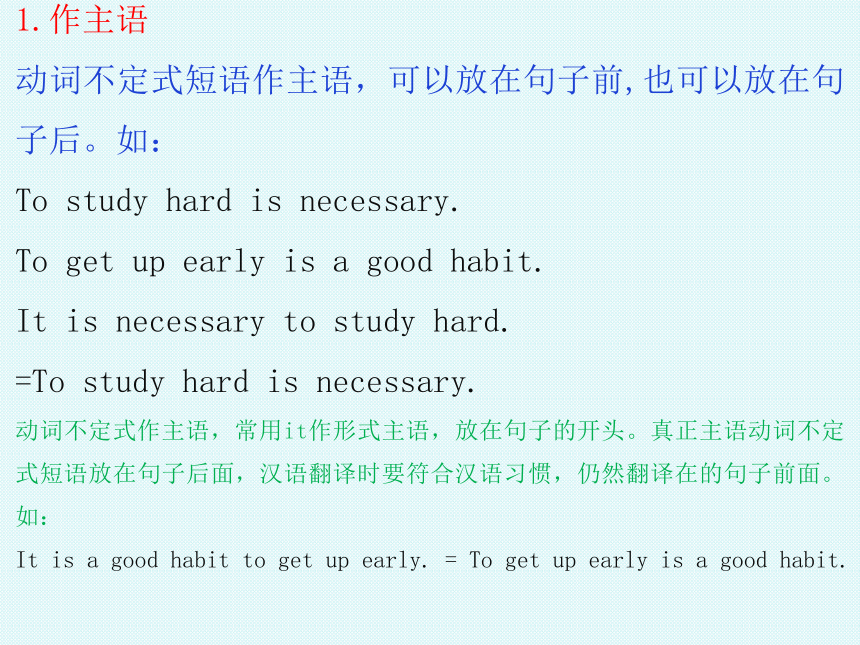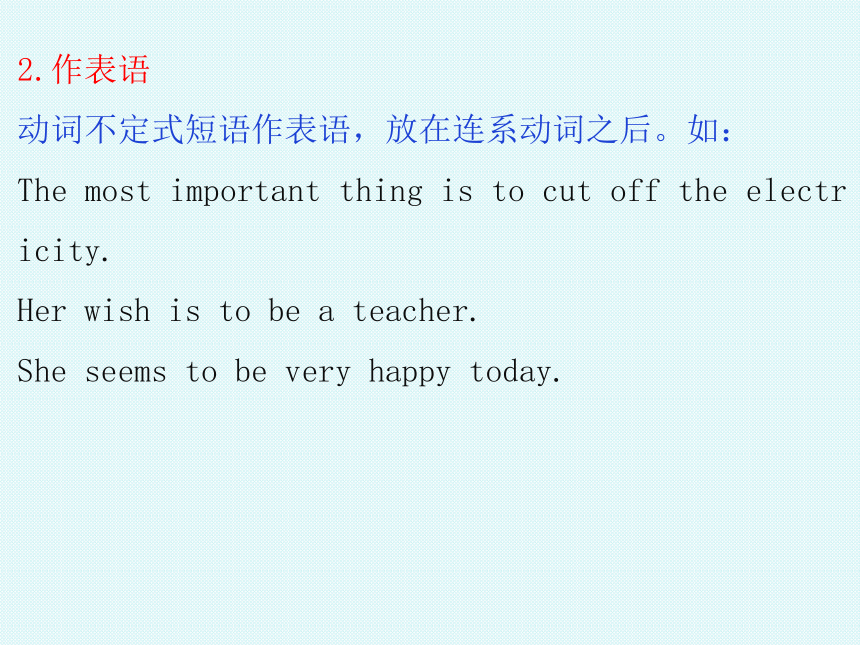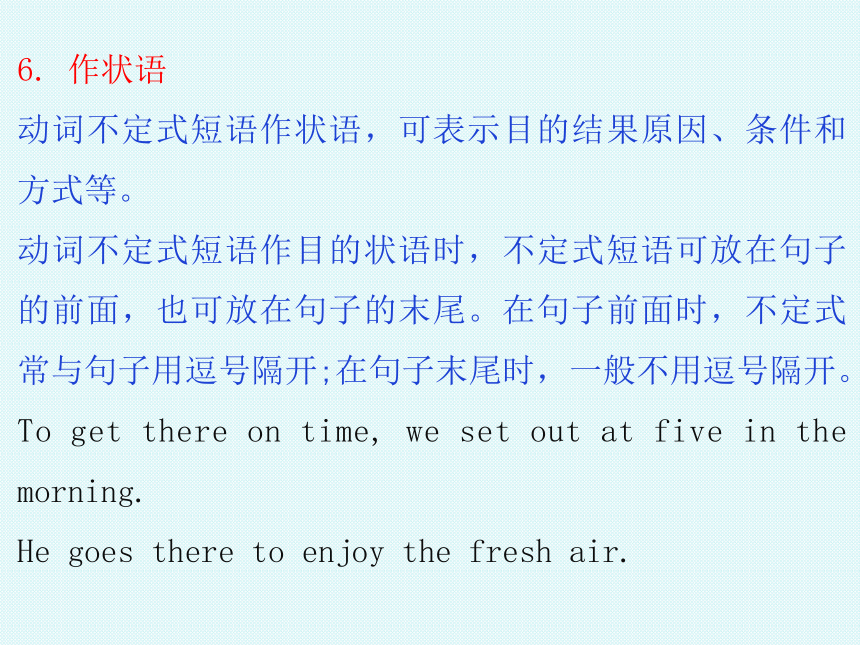中考英语语法大全——非谓语动词(共21张PPT)
文档属性
| 名称 | 中考英语语法大全——非谓语动词(共21张PPT) |  | |
| 格式 | ppt | ||
| 文件大小 | 2.2MB | ||
| 资源类型 | 教案 | ||
| 版本资源 | 通用版 | ||
| 科目 | 英语 | ||
| 更新时间 | 2022-04-10 18:46:13 | ||
图片预览









文档简介
(共21张PPT)
非谓语动词是指动词在句中不能独立作谓语,但同时保留动词某些特征的动词形式。包括不定式、动名词和分词(现在分词、过去分词)三种。它们没有人称和数的变化,但可以有自己的逻辑主语、宾语、状语等。
不定式(to do)
1.作主语
动词不定式短语作主语,可以放在句子前,也可以放在句子后。如:
To study hard is necessary.
To get up early is a good habit.
It is necessary to study hard.
=To study hard is necessary.
动词不定式作主语,常用it作形式主语,放在句子的开头。真正主语动词不定式短语放在句子后面,汉语翻译时要符合汉语习惯,仍然翻译在的句子前面。如:
It is a good habit to get up early. = To get up early is a good habit.
2.作表语
动词不定式短语作表语,放在连系动词之后。如:
The most important thing is to cut off the electricity.
Her wish is to be a teacher.
She seems to be very happy today.
3. 作宾语
动词不定式短语作宾语,放在及物动词之后作动词的宾语。如:
I can't afford to buy a car.我买不起汽车。
Remember to post the letter.记住把信寄了。
I hope to be saying with you.我希望和你住在一起。
4.作定语
动词不定式短语作定语,放在它所修饰的名词之后。如:
I have a letter to answer.我有一封信要回复。
Liu Ying was the girl to meet you.刘英就是来接你的那个女孩子。
I have some clothes to wash.我有些衣服要洗。
I have a wish to go to college.我有一个上大学的愿望。
5. 作宾语补足语
动词不定式短语作宾语补足语,放在宾语的后面,表示宾语时什么或怎么样。动词不定式短语作宾语补足语有 to do和to be两种形式。
The doctor advised him to take a good rest.
I find English to be very easy.
6. 作状语
动词不定式短语作状语,可表示目的结果原因、条件和方式等。
动词不定式短语作目的状语时,不定式短语可放在句子的前面,也可放在句子的末尾。在句子前面时,不定式常与句子用逗号隔开;在句子末尾时,一般不用逗号隔开。
To get there on time, we set out at five in the morning.
He goes there to enjoy the fresh air.
7. 疑问词+不定式
动词不定式短语可以和疑问词连用,组成“疑问词+不定式”结构。该结构相当于一个
名词性从句,在句中可作主语、表语和及物动词或介词的宾语等。如:
How to stop polluting rivers is a big problem. 怎样停止对河流的污染是一个 大问题。(作主语)
The question is how to start the work.问题是怎样开始这项工作。(作表语)
I hardly know what to say before you. 我几乎不知道在你面前该说什么。(作动词宾语)
动名词(doing)
1.作主语
动名词作主语-般表示经常性、习惯性的动作,有时也用it 作形式主语,而把动名词后置。动名词常常被看作是不可数名词,作主语时,谓语用第三人称单数形式。
Taking a cold shower every morning does him good.
Learning English all by yourself not so easy.
Working in these conditions is not a pleasure.
2.作宾语
动名词可作短语动词的实语和介词的实语。
Do you mind my closing the door
I look forward to receiving your letter soon.
I insist on him wearing a suit.
3.作表语
动名词作表语多表示抽象性或习惯性的动作,一般说明 主语的内容。主语、表语的位置常可互换。
My hobby is collecting stamps. =Collecting stamps is my hobby.
My son's favorite sport is playing ping-pong. =Playing ping-pong is my son's favorite sport.
4.作定语
动名词作定语位于被修饰词之前,表示被修饰词的用途。
The old man needs a walking stick(=a stick for walking). Let's buy a washing machine( a machine for washing).
She is reading in the reading room(=the room for reading).
分词
1. 作表语
分词用作表语时已经完全形容词化了,可以被very, rather 等副词修饰。现在分词作表语通常说明主语的性质、特征;过去分词作表语通常说明主语的状态或感受。
eg: The result of the game is very surprising. 游戏的结果让人很惊讶。
eg: We were greatly surprised at the news. 我们听到这个消息后深感意外。
2. 作宾语补足语
现在分词作宾语补足语说明宾语正在进行的动作或宾语的特性,与宾语之间是主动关系。过去分词作宾语补足语表示与宾语之间的被动关系、完成状态或动作由他人完成。
My mother kept me working all the week. 妈妈让我整个星期都在工作。
I heard him singing in the classroom. 我当时听到他正在教室里唱歌。
3. 作定语
作定语的分词具有形容词的性质。单个的分词作定语常放在神修饰词的前面;分词短语作定语常放在被修传词的后面。
eg: I have got a running nose.我流鼻涕。
eg: Do you know the id sanding under the tee 你认识站在树下面的那个女孩吗
4. 作状语
分词在句中可作时间状语原因状语结果状语、条件状语、方式状语或伴随状语等。
eg: Arriving home, he showed me a large bright clean room.
eg: Frightened by the noise outside, the little girl dared not sleep in her bedroom.
非谓语动词是指动词在句中不能独立作谓语,但同时保留动词某些特征的动词形式。包括不定式、动名词和分词(现在分词、过去分词)三种。它们没有人称和数的变化,但可以有自己的逻辑主语、宾语、状语等。
不定式(to do)
1.作主语
动词不定式短语作主语,可以放在句子前,也可以放在句子后。如:
To study hard is necessary.
To get up early is a good habit.
It is necessary to study hard.
=To study hard is necessary.
动词不定式作主语,常用it作形式主语,放在句子的开头。真正主语动词不定式短语放在句子后面,汉语翻译时要符合汉语习惯,仍然翻译在的句子前面。如:
It is a good habit to get up early. = To get up early is a good habit.
2.作表语
动词不定式短语作表语,放在连系动词之后。如:
The most important thing is to cut off the electricity.
Her wish is to be a teacher.
She seems to be very happy today.
3. 作宾语
动词不定式短语作宾语,放在及物动词之后作动词的宾语。如:
I can't afford to buy a car.我买不起汽车。
Remember to post the letter.记住把信寄了。
I hope to be saying with you.我希望和你住在一起。
4.作定语
动词不定式短语作定语,放在它所修饰的名词之后。如:
I have a letter to answer.我有一封信要回复。
Liu Ying was the girl to meet you.刘英就是来接你的那个女孩子。
I have some clothes to wash.我有些衣服要洗。
I have a wish to go to college.我有一个上大学的愿望。
5. 作宾语补足语
动词不定式短语作宾语补足语,放在宾语的后面,表示宾语时什么或怎么样。动词不定式短语作宾语补足语有 to do和to be两种形式。
The doctor advised him to take a good rest.
I find English to be very easy.
6. 作状语
动词不定式短语作状语,可表示目的结果原因、条件和方式等。
动词不定式短语作目的状语时,不定式短语可放在句子的前面,也可放在句子的末尾。在句子前面时,不定式常与句子用逗号隔开;在句子末尾时,一般不用逗号隔开。
To get there on time, we set out at five in the morning.
He goes there to enjoy the fresh air.
7. 疑问词+不定式
动词不定式短语可以和疑问词连用,组成“疑问词+不定式”结构。该结构相当于一个
名词性从句,在句中可作主语、表语和及物动词或介词的宾语等。如:
How to stop polluting rivers is a big problem. 怎样停止对河流的污染是一个 大问题。(作主语)
The question is how to start the work.问题是怎样开始这项工作。(作表语)
I hardly know what to say before you. 我几乎不知道在你面前该说什么。(作动词宾语)
动名词(doing)
1.作主语
动名词作主语-般表示经常性、习惯性的动作,有时也用it 作形式主语,而把动名词后置。动名词常常被看作是不可数名词,作主语时,谓语用第三人称单数形式。
Taking a cold shower every morning does him good.
Learning English all by yourself not so easy.
Working in these conditions is not a pleasure.
2.作宾语
动名词可作短语动词的实语和介词的实语。
Do you mind my closing the door
I look forward to receiving your letter soon.
I insist on him wearing a suit.
3.作表语
动名词作表语多表示抽象性或习惯性的动作,一般说明 主语的内容。主语、表语的位置常可互换。
My hobby is collecting stamps. =Collecting stamps is my hobby.
My son's favorite sport is playing ping-pong. =Playing ping-pong is my son's favorite sport.
4.作定语
动名词作定语位于被修饰词之前,表示被修饰词的用途。
The old man needs a walking stick(=a stick for walking). Let's buy a washing machine( a machine for washing).
She is reading in the reading room(=the room for reading).
分词
1. 作表语
分词用作表语时已经完全形容词化了,可以被very, rather 等副词修饰。现在分词作表语通常说明主语的性质、特征;过去分词作表语通常说明主语的状态或感受。
eg: The result of the game is very surprising. 游戏的结果让人很惊讶。
eg: We were greatly surprised at the news. 我们听到这个消息后深感意外。
2. 作宾语补足语
现在分词作宾语补足语说明宾语正在进行的动作或宾语的特性,与宾语之间是主动关系。过去分词作宾语补足语表示与宾语之间的被动关系、完成状态或动作由他人完成。
My mother kept me working all the week. 妈妈让我整个星期都在工作。
I heard him singing in the classroom. 我当时听到他正在教室里唱歌。
3. 作定语
作定语的分词具有形容词的性质。单个的分词作定语常放在神修饰词的前面;分词短语作定语常放在被修传词的后面。
eg: I have got a running nose.我流鼻涕。
eg: Do you know the id sanding under the tee 你认识站在树下面的那个女孩吗
4. 作状语
分词在句中可作时间状语原因状语结果状语、条件状语、方式状语或伴随状语等。
eg: Arriving home, he showed me a large bright clean room.
eg: Frightened by the noise outside, the little girl dared not sleep in her bedroom.
同课章节目录
- 词法
- 名词
- 动词和动词短语
- 动词语态
- 动词时态
- 助动词和情态动词
- 非谓语动词
- 冠词
- 代词
- 数词和量词
- 形容词副词及其比较等级
- 介词和介词短语
- 连词和感叹词
- 构词法
- 相似、相近词比较
- 句法
- 陈述句
- 一般疑问句和否定疑问句
- 特殊疑问句及选择疑问句
- 反意疑问句
- 存在句(There be句型)
- 宾语从句
- 定语从句
- 状语从句
- 主谓一致问题
- 简单句
- 并列句
- 复合句
- 主谓一致
- 主、表语从句
- 名词性从句
- 直接引语和间接引语
- 虚拟语气
- 感叹句
- 强调句
- 倒装句
- 祈使句
- 句子的成分
- 句子的分类
- 题型专区
- 单项选择部分
- 易错题
- 完形填空
- 阅读理解
- 词汇练习
- 听说训练
- 句型转换
- 补全对话
- 短文改错
- 翻译
- 书面表达
- 任务型阅读
- 语法填空
- 其他资料
